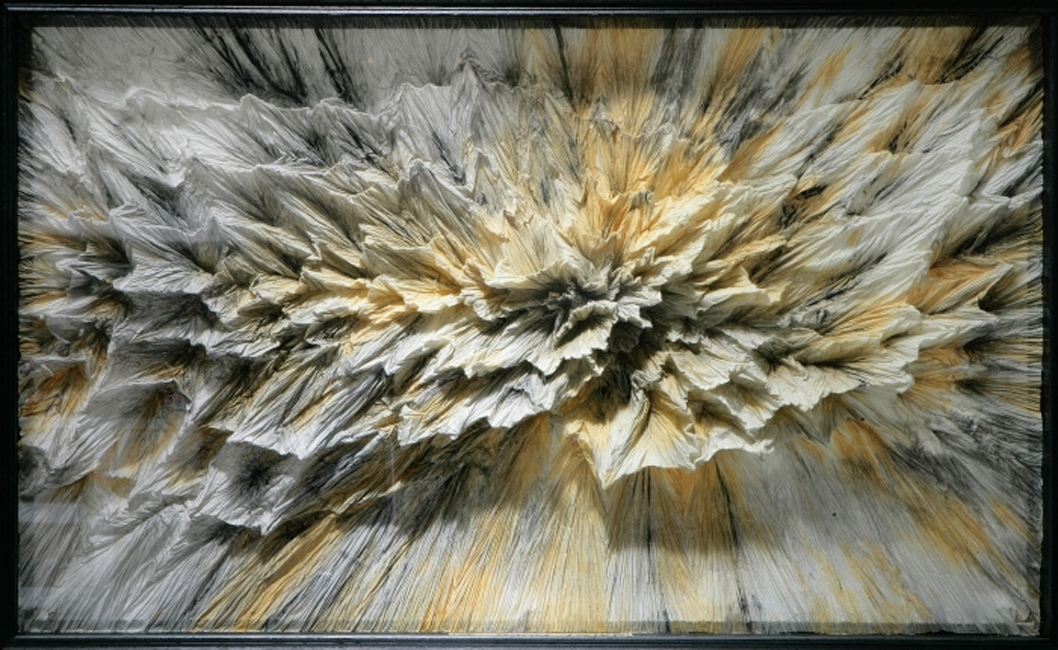
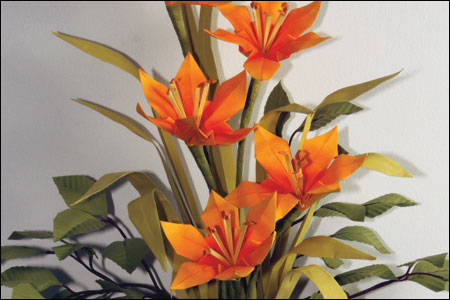
John Blackman
(b.1955, American)
John Blackman’s interest in origami originated as a child and has grown into a passion. His other pursuits are gardening, nature, and Ikebana (the Japanese art of flower arranging), all of which he merges with origami. Today Blackman mainly folds plant and flower forms, often turning them into Japanese-style arrangements. His works have been exhibited at several Origami USA national conventions, libraries, and galleries. Blackman’s works are featured in The Art of Origami by Gay Merrill Gross and The Encyclopedia of Origami by Nick Robinson. His website is origamiflora.com.
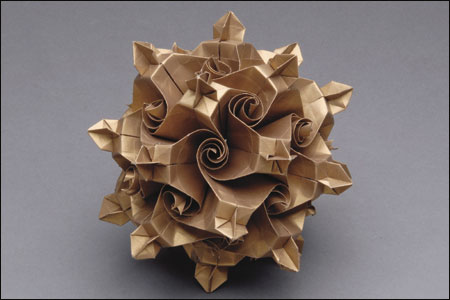 Krystyna and Wojtek Burczyk
Krystyna and Wojtek Burczyk
(b.1959 and 1960, Polish)
Krystyna Burczyk has taught mathematics for more than 20 years. In 1995 she began folding paper, exploring the relationship between origami and mathematics through the creation of geometric models. She is also interested in the educational applications of origami, especially in regard to mathematics, and has written five origami books. Her husband and artistic collaborator, Wojtek Burczyk, also started origami in 1995 and has a similar background in mathematics and computer science. Together they promote origami within their community, and participate in national and international origami exhibitions.
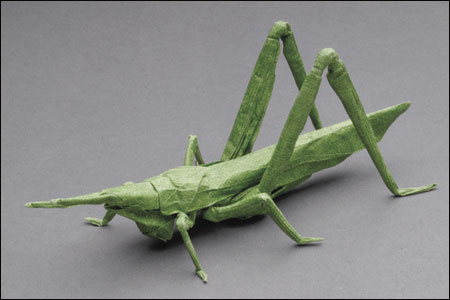 Brian Chan
Brian Chan
(b.1980, Chinese American)
Brian Chan studied origami avidly as a child. While pursuing a degree in mechanical engineering at MIT, a visit by Robert Lang in 2004 re-inspired him to take up folding seriously. Now an instructor at MIT and a freelance artist, Chan is considered one of the world’s foremost origami folders. His eclectic range of complex origami forms includes insects, humans, and figures inspired by fantasy and the visual arts. His origami is displayed on the MIT webpage, web.mit.edu/chosetec/www/origami/.
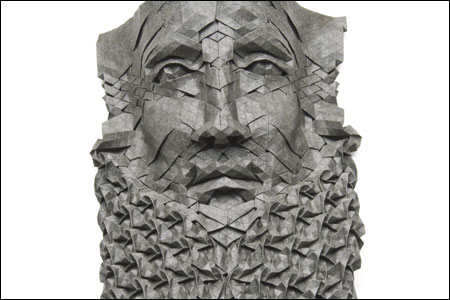 Joel Cooper
Joel Cooper
(b.1970, American)
Joel Cooper studied sculpture with an emphasis on bronze casting at the University of Kansas. He enjoyed origami as a hobby since childhood and became very adept at executing the most complicated models, yet had never designed his own pieces. In 2000 he encountered origami tessellation and was attracted immediately to its potential for complexity, savoring the pure mathematical regularity of tessellations. He soon combined the techniques of origami tessellation with his background in sculpture to create a new style of folding complex masks from single pieces of paper. He has exhibited his works and shares them with others on his blog, joelcooper.wordpress.com.
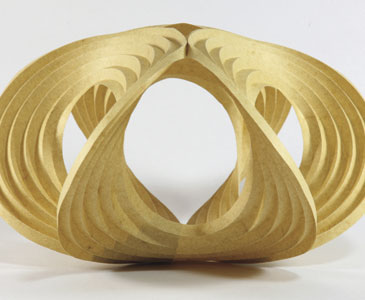 Erik Demaine and Martin Demaine
Erik Demaine and Martin Demaine
(b. 1981 and 1942, Canadian American)
Canadian-born Erik Demaine completed his Bachelor of Science degree by age 14 and his Ph.D. by age 20. His dissertation, a seminal work in the field of computational origami, received national awards and won him a MacArthur Fellowship. Since joining the MIT faculty in 2001, he has been the leading theoretician in computational origami, the study of what can be done with a folded sheet of paper, and he is exploring origami applications in architecture, robotics, and molecular biology. Artistically, he collaborates with his artist father, Martin Demaine, to create “Curved-Crease” sculptures and other unconventional origami works. His website is erikdemaine.org.
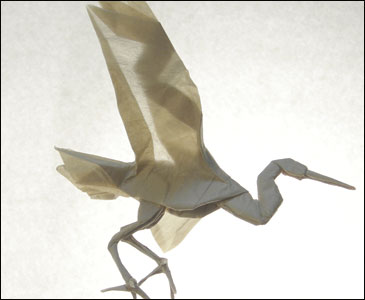 Roman Diaz
Roman Diaz
(b.1968, Uruguayan)
Roman Diaz was born in Montevideo, Uruguay, and lived in Argentina, Honduras, and Mozambique as a child. During his travels Diaz occasionally experimented with origami. He returned to Uruguay, completed his studies and became a veterinarian. Fascinated by the possibilities of origami, he started designing his own models. By 2005 his designs of animals were attracting international attention. Since then he has been a special guest at origami conventions in Spain, France, Italy, Germany, and Chile and has published two books.
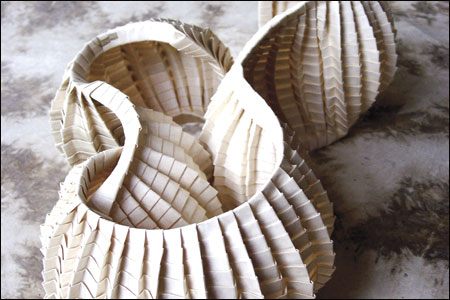 Christine Edison
Christine Edison
(b.1975, American)
Christine Edison is a teacher and paper folder based in Chicago. She started folding seriously around 2003 and since 2006 has been specializing in tessellations. Her work varies from intricately detailed tessellations to bold sculptural pieces. She blogs about her origami and other interests at cedison.wordpress.com.
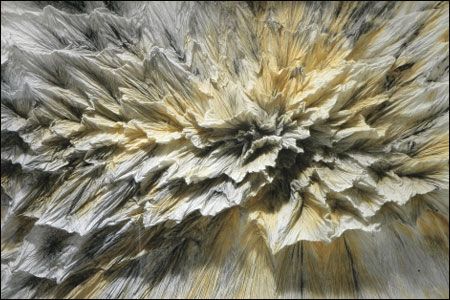 Vincent Floderer
Vincent Floderer
(b. 1961, French)
Vincent Floderer has moved away from conventional origami and has developed a whole new vocabulary of techniques, most famously crumpling. The inspiration for his crumpling came originally from English folder Paul Jackson, but he has developed Jackson’s ideas further and has evolved methods—including dampening and stretching—that have allowed him to create organic forms such as mushrooms and toadstools and multi-layered forms such as corals and sponges. Turning paper inside out has also resulted in organic abstract creations. His website is le-crimp.org.
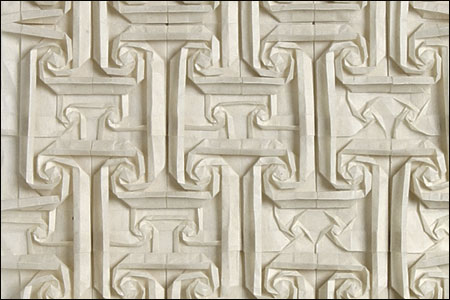 Tomoko Fuse
Tomoko Fuse
(b.1951, Japanese)
Tomoko Fuse first learned origami while in the hospital as a child. She is widely considered one of the world’s pre-eminent modular origami artists and has designed many modular boxes and containers, polyhedra, and other geometric objects, as well as kusudama (balls made by sewing or gluing together separate, usually flower-shaped, units), paper toys, and masks. Since the early 1980s she has published over 60 books in Japanese, Korean, and English.
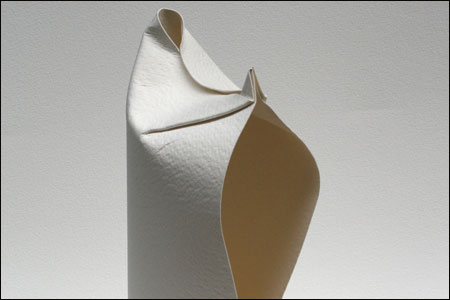 Giang Dinh
Giang Dinh
(b.1966, Vietnamese American)
Giang Dinh was born in Hue, Vietnam. He studied architecture in Vietnam and in the United States and currently lives in Virginia, where he works for an architectural firm. He started creating origami in 1998 and is now well known for his simple and elegant designs infused with a zen-like spirituality. Rather than crisp, sharp folds, which he compares to ink, he chooses soft folds, which are like pencil lines. He often works in plain white paper so that the viewer can concentrate on the pure form and shadow of the work. Many of his works are wet-folded and have the appearance of semi-abstract sculptures. His website is giangdinh.com.
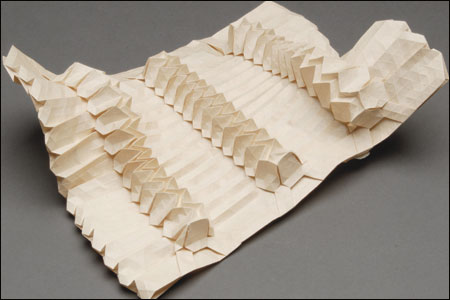 Eric Gjerde
Eric Gjerde
(b.1978, Norwegian American)
At age five, Eric Gjerde wanted to be “a paperologist,” and growing up, he enjoyed paper crafts and origami. After preparing for a technology career, Gjerde kept looking for an artistic outlet to balance his creative side with his professional life. He returned to his childhood love of paper, and currently focuses on the geometric art of origami tessellations. He teaches, exhibits his works, and has written Origami Tessellations: Awe-Inspiring Geometric Designs to introduce readers to the incredible beauty and diversity of origami tessellations. His website is origamitessellations.com.
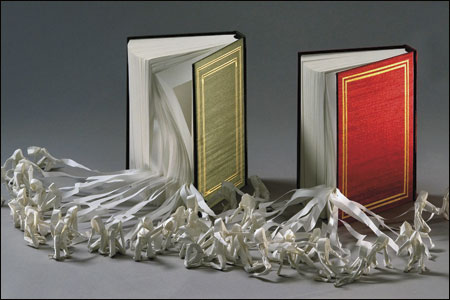 Miri Golan
Miri Golan
(b.1965, Israeli)
Miri Golan is probably best known for the educational work she does in Israel, using origami to unite people of different religious and cultural backgrounds. Her students often create garlands of origami cranes as a wish or prayer for a more peaceful world. Golan, who is married to English origami artist Paul Jackson, also creates conceptual pieces, such as Two Books, in which origami figures emerge from the pages of two sacred texts, the Torah and the Koran, and reach out to each other. More information about her educational programs can be found at foldingtogether.org.
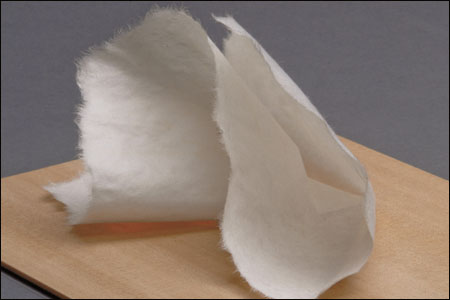 Koshiro Hatori
Koshiro Hatori
(b.1961, Japanese)
Koshiro Hatori is a professional translator and origami artist who has made significant contributions to the academic study of origami. His research has led to breakthroughs in the mathematics of origami as well as the history of this art form both in Japan and the West. His designs range from traditional origami to abstractions, crumpled forms to pleated sculptures. His website is origami.ousaan.com.
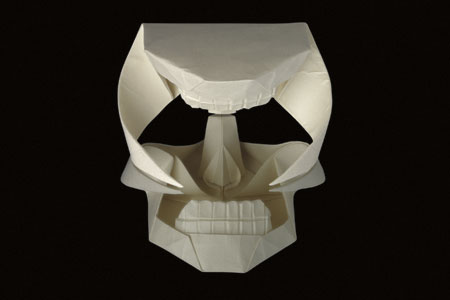 Herman Van Goubergen
Herman Van Goubergen
(b.1961, Belgian)
Belgian folder Herman van Goubergen is a computer programmer and has been creating origami since he was 14 years old. His designs are known for their playful trompe l’oeil quality, as they are not always what they first appear to be. He creates new works infrequently, and each piece is scrupulously based on a novel origami concept that challenges conventional notions of folding. In all his projects van Goubergen seeks to create a work that encapsulates and demonstrates the innovative concept he is exploring.
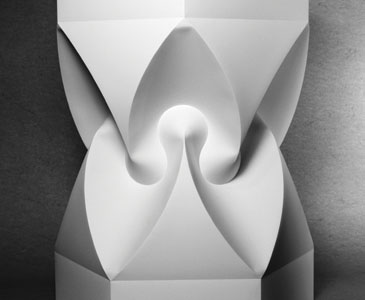 David Huffman
David Huffman
(1925–1999, American)
David Huffman was an electrical engineer best known for the invention of the Huffman code, a compression scheme which enables the consolidation and transmission of digital data, used in fax machines, modems, computer networks, and high-definition television (HDTV). Dr. Huffman was also a pioneer in developing the mathematics of origami, including 3D polyhedral and curved forms. In contrast to traditional origami, which was primarily representational and used straight folds only, Huffman developed abstract and geometric structures based on curved folds, inspiring artists Erik and Martin Demaine and Jeannine Mosely, among others.
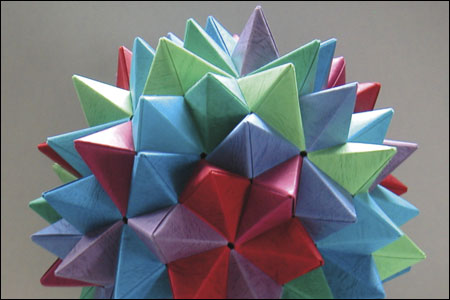 Tom Hull
Tom Hull
(b.1969, American)
Tom Hull is an associate professor of mathematics at Western New England University in Massachusetts. He is known as a preeminent authority on the mathematics of paper folding. Hull’s own research has developed some of the mathematical foundations of origami, and his historical analysis has uncovered previously neglected mathematical origami contributions by other scholars. His passion for teaching often combines origami and mathematics, and he regularly teaches origami math to classes ranging from high school to advanced college seminars. His book, Project Origami, explains how origami can be used to teach math—not just geometry, but also calculus, abstract algebra, topology, and more. His origami works, which are mostly modular forms, display the intersection of mathematics and art.
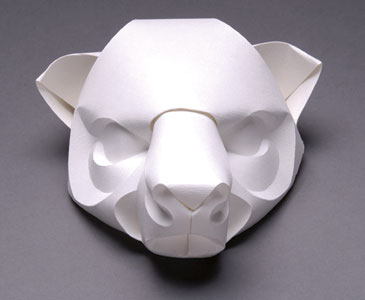 Roy Iwaki
Roy Iwaki
(1935–2010, Japanese American)
Roy Iwaki was born in Los Angeles and was six years old when war broke out with Japan and he was sent with his mother and older siblings to the Manzanar Relocation Camp. After the war he enlisted in the Air Force and then went on to study architecture. Before starting his career, he visited Japan, and developed an admiration for Japanese art, including woodblock printing and origami. After two years as an architect, he relinquished that career to pursue his passion for working with his hands. Iwaki first created his origami masks in the late 1960s and was making these and other works of art until his death in 2010.
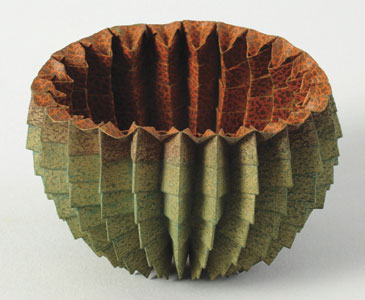 Paul Jackson
Paul Jackson
(b.1956, British)
Paul Jackson’s childhood hobby was origami. After art school in London, he taught folding techniques, wrote books about paper art, and in the 1990s started exhibiting his origami. In 2000 he met Israeli artist Miri Golan and relocated to Israel, where he now teaches at art and design colleges. In contrast to the complex, detailed origami of many artists, Jackson’s paper sculptures aspire to be “simple, elegant in sequence and form, surprising in concept and even audacious.” He prefers forms that appear to have been “discovered” in the paper, rather than “contrived” from it. His website is origami-artist.com.
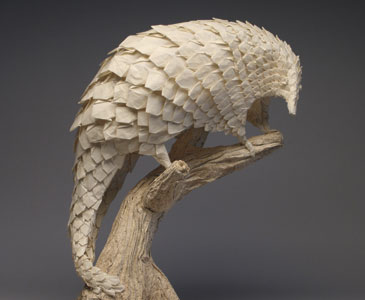 Eric Joisel
Eric Joisel
(1956–2010, French)
Eric Joisel was widely regarded as one of the most talented origami artists in the world. A sculptor with a background in history and law, Joisel was inspired by the works of Yoshizawa to turn his hands to origami. Largely self-taught in origami principles, he combined design techniques like box-pleating, folding techniques such as wet-folding, and tools he seamlessly adapted from his sculptural background to create figures and animals that appear sculpted or molded rather than folded. Joisel turned single uncut sheets of paper into wondrous creations. He excelled at animals, whimsical fantasy figures such as dwarves and wizards, and masks, sometimes depicting the faces of fellow origami enthusiasts. Before he died, he was working on a group of meticulously costumed characters from the Commedia dell’Arte. His work can still be enjoyed on his website ericjoisel.com.
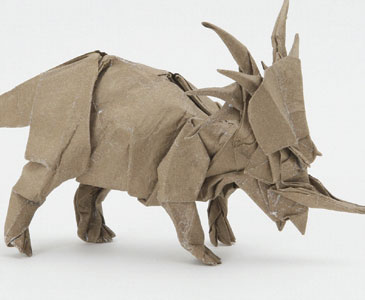 Satoshi Kamiya
Satoshi Kamiya
(b.1981, Japanese)
Despite his young age, Satoshi Kamiya is one of the most advanced origami folders in the world. He started folding paper at age two and began designing more sophisticated models at age 14. At age 17, he was invited onto a Japanese game show, “Origami TV Champion,” where he won the competition against artists twice his age, and proceeded to do so for the next three years straight. He has made hundreds of origami models, drawing inspiration from nature, Eastern and Western mythology, manga, and even video game characters. Many of Kamiya’s origami designs are exceptionally complex—some of his dragons require around 275 steps—while others, such as his Eastern Dragon, which took 40 hours to fold, are so complex that they will likely never be diagrammed for instruction.
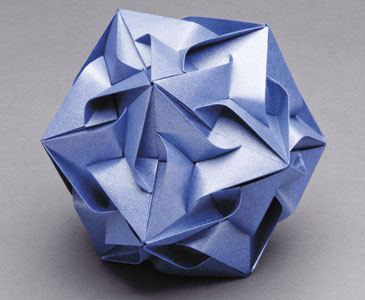 Miyuki Kawamura
Miyuki Kawamura
(b.1970, Japanese)
Miyuki Kawamura began origami at the age of two and has been folding paper since then. She is a well respected folder in Japan and is a board member of the Japan Origami Academic Society. Kawamura has a background in physics and specializes in modular origami. She has published several books about origami including Polyhedron Origami for Beginners in 2002 and has exhibited her work internationally.
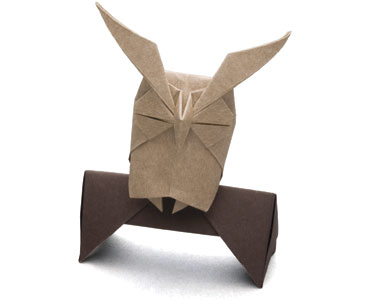 Hideo Komatsu
Hideo Komatsu
(b.1977, Japanese)
Hideo Komatsu began folding origami at the age of three and became passionate about it in elementary school after reading the book Viva Origami (1983) by Kunihiko Kasahara, which featured works by Jun Maekawa. He later became a member of the Japanese group Tanteidan (Origami Detectives) and has been very actively involved in their publication Oru (Fold). In 1998, he was invited to be a guest folder at the Origami USA Convention, which took him overseas for the first time. His works, mostly elegantly stylized animal forms, have been featured in several international exhibitions.
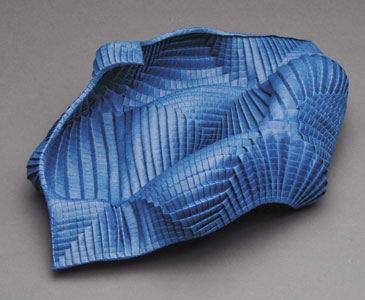 Goran Konjevod
Goran Konjevod
(b.1973, Croatian American)
Goran Konjevod is a mathematician and theoretical computer scientist who originally practiced origami as a hobby. In 2005, he began creating his own designs. His pieces are mostly abstract shapes formed by tension in the paper when multiple layers are arranged according to their regular or irregular patterns. Their final forms are, in a sense, organically discovered rather than invented or designed. Although he generally works with single uncut sheets of paper or other foldable material (such as copper) and for the most part employs very simple folds, he also creates three-dimensional forms using multiple layers of thicker paper. Konjevod’s work has been featured in exhibitions throughout the United States, Canada, Spain, and Croatia. His website is organicorigami.com.
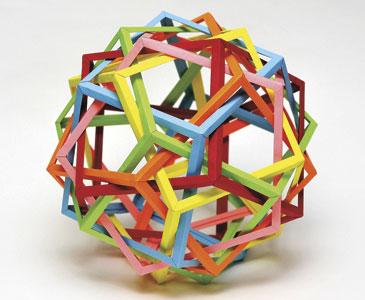 Daniel Kwan
Daniel Kwan
(b.1986, Chinese American)
Daniel Kwan started folding origami at age five in Chinese school and avidly studied origami books by Tomoko Fuse and others. He has been attending Origami USA conventions since 1997, and in around 2002, he began designing his own modular origami pieces. He has developed a specialty of using edge-based modules to weave together various polyhedra compounds (of which the two models in this exhibition are examples). As of 2008, he has expanded his focus in the origami world to include tessellations.
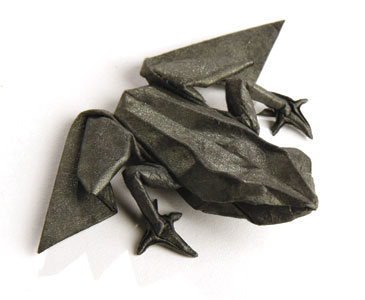 Michael G. LaFosse
Michael G. LaFosse
(b. 1957, American)
Michael G. LaFosse is internationally regarded as one of the world’s top origami masters. He has been practicing origami for more than 40 years and has been teaching it for over 30 years. LaFosse, a master paper-maker, and his partner, Richard Alexander, also create handmade origami paper, known worldwide under the name “Origamido® Paper,” which they use for their own work and is also sought after by many other origami artists. Together, LaFosse and Alexander have written numerous books on origami. A biologist by training, LaFosse skillfully uses the wet-folding technique and his own specially made papers to create dynamic representations of the natural world. His website is origamido.com.
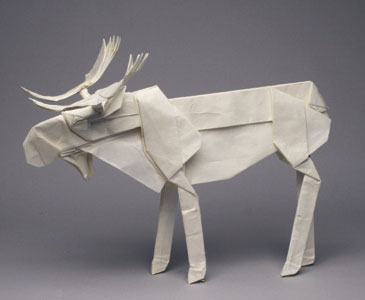 Robert J. Lang
Robert J. Lang
(b. 1961, American)
After 30 years of studying origami as his passion, Dr. Robert J. Lang gave up his day job as a laser physicist to focus on both the art and science of origami. He is now one of the most respected origami artists in the world and uses his background in science and mathematics to design complex and lifelike forms from uncut squares of paper. Although Lang uses mathematics (and even, on occasion, computer programs) in his work, he has developed many design techniques that require no more than a pencil and paper. Lang teaches classes and workshops on the techniques he invented, and his book, Origami Design Secrets, is considered one of the seminal references for origami design. Lang lectures widely and has collaborated with other scientists, doctors, and engineers to apply his knowledge of folding to the design of airbag deployment software, space telescope optics, and medical devices. His website is langorigami.com.
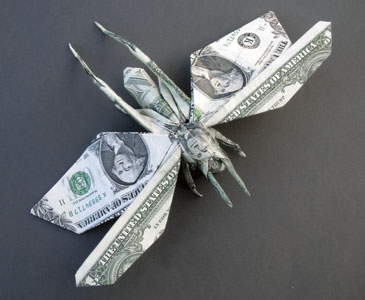 Sipho Mabona
Sipho Mabona
(b.1980, Swiss/South African)
Sipho Mabona, of Swiss and South African background, was five years old when he folded his first paper airplane. Since then, Mabona’s origami has covered a great range of different styles, from very intricate, representational designs to abstract geometrical shapes. Recently, he has created a number of thought-provoking origami installations, bearing powerful social messages about environmental destruction and the dangers of consumerism. He also designed origami for the award-winning Asics corporate movie Origami in the Pursuit of Perfection, which is featured in this exhibition.
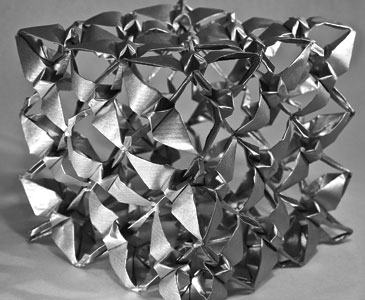 Linda Tomoko Mihara
Linda Tomoko Mihara
(b.1959, Japanese American)
Linda Tomoko Mihara learned origami at the age of six from her grandfather Tokinobu Mihara, author of Origami—Japanese Art of Paper Folding. Mihara is best known for her work with folded cranes, in particular her three-dimensional origami sculptures. She is an expert in the roko-an technique, in which multiple cranes are folded from a single sheet of paper. This style was based on a series of two-dimensional works illustrated in the 18th century book Hiden Senbazuru Orikata (Secret Folding Methods for One Thousand Cranes). Mihara created her works, Crane Cube and Peace Sphere, after developing this technique for many years. Roko-an is demanding for both the artist and the paper; it took five years to find the right type of paper to realize the Peace Sphere, a free-standing, round sculpture. Her website is origamihara.com.
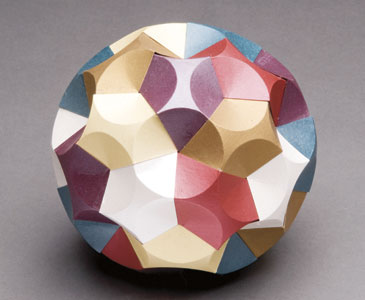 Jeannine Mosely
Jeannine Mosely
(b.1953, American)
Jeannine Mosely has loved origami since the age of five. A graduate of MIT with a Ph.D. in electrical engineering and computer science, she has pursued a career in three-dimensional modeling. Best known for her Menger sponge, a cube measuring 1.5 meters (5 feet) on one side and made from 66,048 folded business cards, Mosely believes that folding origami structures is a way of giving life to a mathematical theorem or formula. Her recent origami work focuses on folding curved lines, both in modular forms and tessellations.
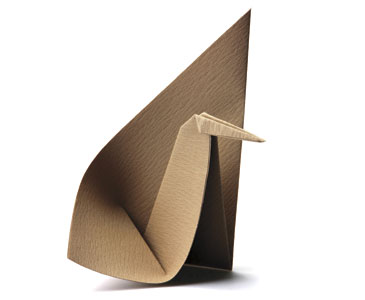 Paulo Mulatinho
Paulo Mulatinho
(b.1956, Brazilian)
A native of Brazil, Paulo Mulatinho studied graphic and industrial design in Rio de Janeiro. He has been folding origami for over twenty years and has lived in Germany since 1985. Paulo Mulatinho is the founding president of Origami Germany. He has written several books about origami in English and German and has exhibited his works internationally.
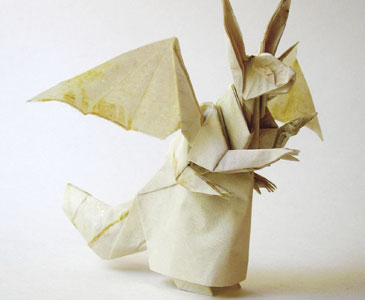 Jared Needle
Jared Needle
(b. 1987, American)
One of the younger artists featured in the exhibition, Jared Needle has been folding paper since he was a child and has recently begun exhibiting his own designs at national conventions and exhibitions. Many of his works are inspired by the world of fantasy and the supernatural, in particular the characters featured in anime and video games.
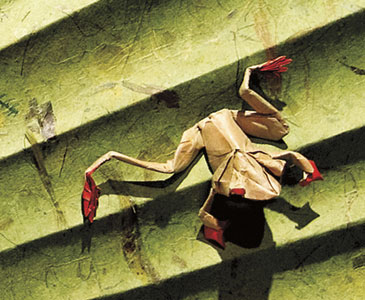 Bernie Peyton
Bernie Peyton
(b. 1950, American)
Bernie Peyton has a background in wildlife biology and spent many years conducting field research and conservation on endangered species, including spectacled bears in the Andes. In the late 1990s he revived a childhood interest in origami and started creating his own designs. Many of his pieces are sculptural in composition, relate to his work with wildlife, and feature elements made from folded paper mounted on structures to enhance their realism. His website is berniepeyton.com.
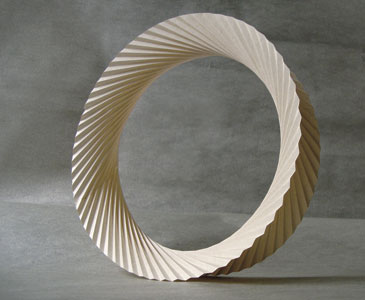 Andrea Russo
Andrea Russo
(b. 1981, Italian)
Andrea Russo has a background in law and a passion for art, which he expresses through his origami works. Rather than rely on traditional and conventional forms of origami, he prefers to create tessellations with geometric patterns and abstract sculptures using straight lines or curves, in an attempt to extract new forms and visual concepts. He has collaborated with designers and architects and has exhibited his work in museums and private galleries. Russo recently participated in a convention of Islamic Art, where he showcased paper tessellations that represented Islamic geometric patterns.
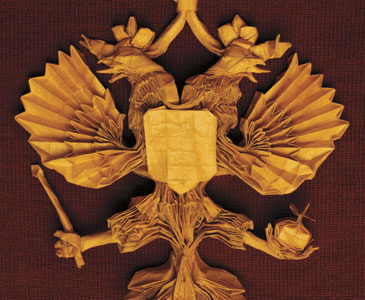 Victoria Serova
Victoria Serova
(b.1969, Russian)
Victoria Serova is one of the few female origami folders to specialize in complex origami forms such as multi-legged insects and crustaceans. Her husband, Vladimir Serova, is also an origami artist, and together they have published several novels and exhibited their work in books and exhibitions throughout the world. Their joint website is vs-origami.ru.
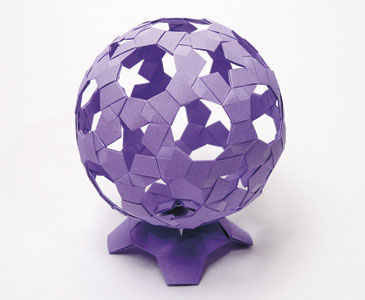 Heinz Strobl
Heinz Strobl
(b. 1946, German)
Heinz Strobl is known for his development of two types of modular origami using strips of paper. In Knotology, the strips are knotted into flat pentagons layered on one another, and woven and plaited to make models that, like his Snapology figures, are stable without the use of glue or tape. In Snapology, which he developed later, strips are folded into polygonal prisms (the units or modules) that are joined using a second set of strips that snap them together, creating geometric forms. He has exhibited his works internationally.
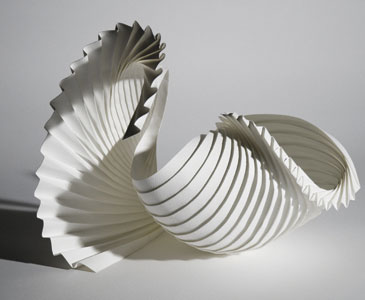 Richard Sweeney
Richard Sweeney
(b.1984, British)
Richard Sweeney studied sculpture and three-dimensional design in art school. As part of Sweeney’s work with three-dimensional design, he manipulated paper by hand to create 3-D design models, many of which ultimately developed into sculptures. Combining hand-craft with computer-aided design and CNC (computer numerical control) manufacturing techniques, Sweeney seeks to maintain an experimental, hands-on approach, utilizing the properties of often mundane materials, such as paper, to discover unique sculptural forms. His website is richardsweeney.co.uk.
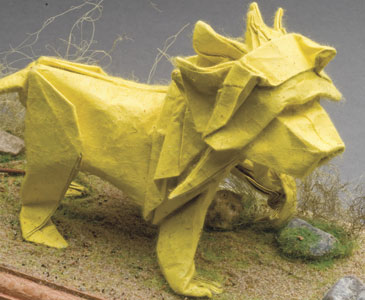 Nicolas Terry
Nicolas Terry
(b. 1974, France)
A psychotherapist with a background in engineering and molecular chemistry, Nicolas Terry discovered origami as a child and in 2002 started creating his own designs, beginning with a snail. Since then, he has designed numerous forms, mostly of animals, given presentations, and exhibited internationally. Terry has published books featuring his artwork, and has also worked to promote and publish the works of other internationally renowned folders. His website is passion-origami.com.
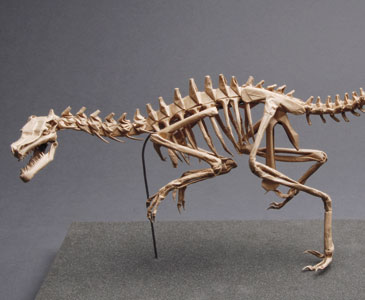 Hieu Tran Trung
Hieu Tran Trung
(b.1984, Vietnamese)
Hieu Tran Trung is a chemistry teacher living in Ho Chi Minh City, Vietnam. He has been folding since age four. Tran recently joined a growing group of Vietnamese origami folders and his work has been featured in several international exhibitions. Fascinated by dinosaurs, he specializes in constructing complex skeletons of various types of dinosaurs from multiple sheets of paper.
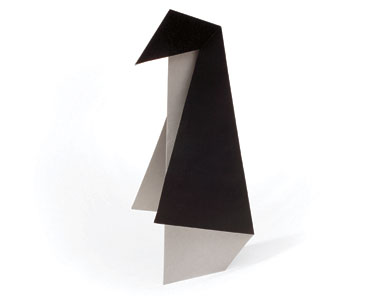 Florence Temko
Florence Temko
(1921–2009, American)
Florence Temko was born in the United Kingdom and was a pioneer in spreading origami throughout both the UK and the United States, where she later lived. A prolific author on the subject of origami, she was a strong influence on origami beginners, many of whom went on to become renowned artists. Several of her designs, such as a family of penguins, are among the most popular with young folders.
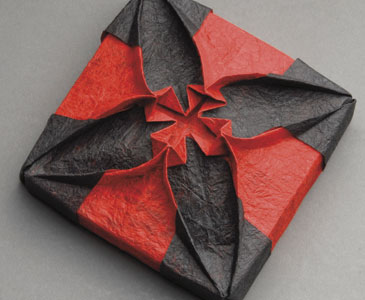 Arnold Tubis
Arnold Tubis
(b.1932, American)
Arnold Tubis taught physics at Purdue University for 40 years. Origami has been an avocation of his since the early 1960s and he has co-authored four books on the subject. Tubis has also published seven articles on the use of origami in mathematics education, and served as a consultant to the InCreasing Math (origami math) project of the Dramatic Results Organization that operates in the public schools of Long Beach and Compton, CA. His works have been exhibited in the USA, Japan, Europe, and Israel.
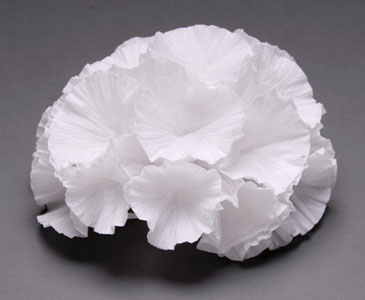 Polly Verity
Polly Verity
(b.1971, British)
Polly Verity is an artist based in Devon, England. She sculpts in a wide range of media and performs as a member of an experimental electronic band called “I,” playing purpose-built and modified instruments. Her paper sculptures explore patterns and shadows and are complex and varied, from organic crumple forms to elaborate tessellations, often including curved folds. Her website is polyscene.com.
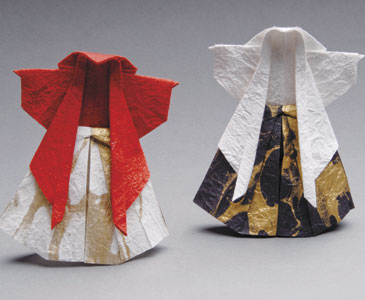 Makoto Yamaguchi
Makoto Yamaguchi
(b. 1944, Japanese)
Yamaguchi became a professional origami creator after working with the Nippon Origami Association. In 1989, he opened Gallery Origami House in Tokyo, a venue that showcases the works of origami folders. Yamaguchi encourages young creators to improve their models and exchange ideas and techniques with origami enthusiasts overseas. He travels extensively teaching the art of origami, and his passion has led to involvement with origami associations around the world. The Origami House website is origamihouse.jp.
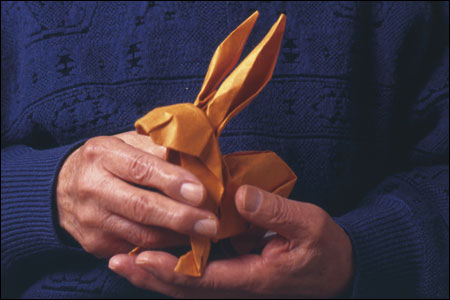 Akira Yoshizawa
Akira Yoshizawa
(1911–2005, Japanese)
Akira Yoshizawa is widely considered the father of modern origami art. The son of a farmer, he devoted his life to his art, living in poverty as he perfected his craft and developed thousands of new designs. He pioneered the now widely used technique of “wet-folding,” which allows for delicate sculptural modeling of organic forms. In 1954, he was propelled to prominence by his book, Atarashi Origami Geijutsu (New Origami Art), which introduced a system of folding notation. The same year, he founded the International Origami Center in Tokyo and began holding origami exhibitions overseas, serving as a cultural ambassador for Japan. In his last decades Yoshizawa received worldwide recognition for his contributions; he wrote 17 more books on origami and in 1983 Emperor Hirohito awarded him the Order of the Rising Sun.
